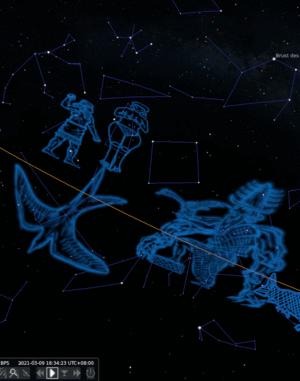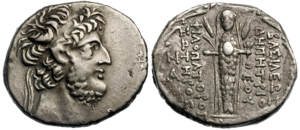Anunitu
Anunitu
Name of the area (constellation) that is now considered the head and breast of Andromeda and the northernmost part of Pisces. As "Anunitu" is an obsolete name for the region of Andromeda, we suggest the term to be used as a star name in Andromeda.
Babylonian deity
Anunnītu(m). By-name of the goddess Ištar, originally a local hypostasis of particular importance to the dynasty of Akkad. The association with ‘fish’ (cf. SpTU III 228, mulNu-nu ‘fish’ = dA-nu-ni-tú/ti) seems to be based on the partial homophony with Akk. nūnu ‘fish’. cf. the association of Anunnītu(m) with the ‘Tigris-star’ in Hg: mul.ídIdigna = dA-nu-ni-tu4 (MSL 11, 40: 229).
Mentioning in MUL.APIN I i 42:
- original: DIŠ MUL ša EGIR mulAŠ. IKU GUB-zu mulA-nu-ni-tu4
- Akkadian: kakkabu ša arki Ikî izzazzu Anunītu
- English: The asterism which stands behind the Field: Anunitu.
Transformation from Anunitu to Andromeda
Ištar is a Babylonian goddess of love (and war), so she has analogies in all other cultures. The Dea Syria was also a goddess of love. She was worshipped as Derketo or Goddess of Ashkelon in the area of present day Israel, and as Atargatis further north in Manbij (Bambyke) in present day Syria. The Goddess of Ashkelon is a syncretism of the Babylonian Ištar and the Egyptian Isis for the area of Ashkelon belonging occasionally to one or the other kingdom.
The ancient lore of Andromeda is said to originat from Jaffa (Joppa/ Yafo, modern day Tel Aviv) by the ancient historians (Strabo, Flavius Josephus), and the city of Ashkelon is only 40 km south along the Mediterranean coastline.
Derketo, the goddess of love from Ashkelon is depicted with fish around her or even with a fish-tail. This way, she is depicted on Greek coins. So, Derketo is half-fish.
The Babylonian name "Anunitu" is homophon with the Akkadian term "nūnu" for fish, so the name contains a reference to the fish-like goddess (who is known as a syncretism anyway).









